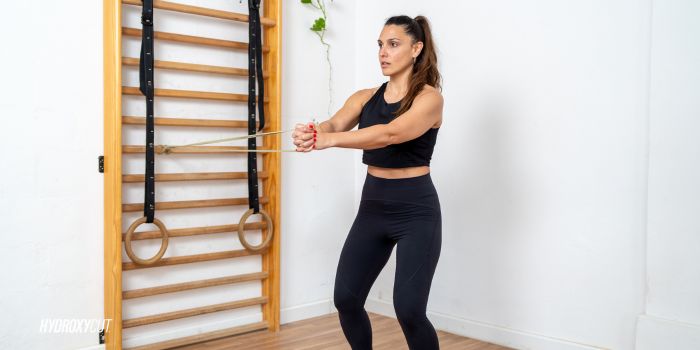Doing endless crunches and sit-ups hasn’t helped most people get the results they want around their midsection.
That’s because traditional core workouts often miss one key component: rotational movement. In real life, your body doesn’t just move up and down; it twists, stabilizes, and transfers force diagonally. That’s exactly why the woodchop exercise is one of the most underrated movements in any serious training plan.
Unlike basic ab exercises, the woodchop works your entire core, especially the obliques, the muscles on the side of your torso that play a big role in posture, balance, and core definition. It’s a move that mimics chopping wood, but don’t let the simplicity fool you; this exercise is dynamic, functional, and scalable for all fitness levels.
According to the Journal of Strength and Conditioning Research, exercises that involve rotation and anti-rotation, like the woodchop, recruit more muscles and engage the core deeper than isolated crunch-based routines. That means better muscle engagement, improved coordination, and real functional strength.
And when combined with a consistent routine, balanced eating habits, and the right support like Hydroxycut’s scientifically backed formula, you give yourself a solid foundation for measurable improvement.
Check out the new Hydroxycut HUNGER CONTROL
Table of contents
This blog breaks down:
What the woodchop exercise is and why it works
How to do it correctly with dumbbells, cables, or bands
A sample routine you can try today
And how Hydroxycut fits into the bigger picture
If you’re ready to stop wasting time on crunches that don’t move the needle, let’s look at an exercise that does something useful for your core and progress.
What Is the Woodchop Exercise?
The woodchop exercise is a rotational movement that mimics the motion of swinging an axe to chop wood. But you don’t need an axe or a forest. Just a dumbbell, cable machine, or resistance band. What makes this move stand out is its combination of strength, control, and movement across multiple planes. It’s a full-body, core-centered exercise that trains the body to move the way it does in everyday life.
What Muscles Does It Target?
While the woodchop primarily focuses on the core and the obliques, it also activates several other muscle groups:
Rectus abdominis (the “six-pack” muscles)
Transverse abdominis (deep core stabilizer)
Obliques (sides of your waist)
Shoulders and upper back
Glutes and legs (for stability and balance)
Types of Woodchop Variations
Here are three accessible versions:
1. Dumbbell Woodchop
Beginner-friendly
Great for home workouts
Allows you to move at your own pace and focus on form
2. Cable Woodchop
Ideal for controlled, smooth resistance
Easily adjustable based on your strength level
Offers multiple angles (high-to-low, low-to-high, horizontal)
3. Resistance Band Woodchop
Perfect for travel or tight spaces
Increases core engagement due to constant tension
Budget-friendly and versatile
A study in the Journal of Orthopaedic & Sports Physical Therapy found that rotational exercises produce higher levels of core muscle activation than traditional ab movements like crunches or sit-ups.
Benefits of the Woodchop Exercise (Backed by Science)
The woodchop exercise may look simple, but the benefits go far beyond just working your sides. When done correctly and consistently, it can improve your fitness, posture, and core strength in ways traditional ab exercises simply can’t match. Here’s why the woodchop deserves a spot in your routine—and what science has to say about it.
1. Builds Real Core Strength
The woodchop targets more than just surface-level muscles. It strengthens your entire core system, including deep stabilizers like the transverse abdominis. These muscles are responsible for protecting your spine and maintaining balance and coordination. A study published in the Spine Journal emphasized that rotational exercises improve spinal stability, reduce injury risk, and develop better neuromuscular control.
2. Activates More Muscles with Every Rep
Unlike isolated ab movements, the woodchop is a compound movement. That means it activates multiple muscle groups at once, increasing the effectiveness of your training session.
Your core resists and controls rotation
Your legs and glutes stabilize your lower body
Your arms and shoulders guide the motion
According to the Journal of Strength and Conditioning Research, exercises that engage both the upper and lower body simultaneously demand more energy and muscular coordination, leading to better results in less time.
3. Helps Shape and Define the Midsection
While no exercise can target a specific spot for results, woodchops train the muscles that wrap around your waist, especially the obliques. Over time, this contributes to a more tapered, athletic look when you do it as a consistent routine.
4. Supports Balance, Stability, and Everyday Movement
The twisting, diagonal motion of the woodchop mimics real-life activities like lifting groceries, rotating in sports, and even turning to grab something behind you. This makes it a functional exercise that translates directly to better movement in daily life. It improves:
Core control
Balance and posture
Reaction time in dynamic settings (sports, running, etc.)
So, while it’s helping you shape your midsection, it’s also building a more capable, injury-resistant body.
How to do the Woodchop Exercise Properly?
The woodchop exercise is only effective if you do it with control and proper form. The movement should be powerful, but not rushed. It’s not about speed; it’s about precision. Let’s go through the most popular and practical versions of the woodchop exercise so you can start doing it safely and effectively, either at home or in the gym.
1. Dumbbell Woodchop (Beginner-Friendly)
This version is ideal if you’re just starting or working out at home.
How to do it:
Stand with feet shoulder-width apart, holding a dumbbell with both hands.
Bring the dumbbell above your right shoulder.
In one controlled motion, bring it diagonally across your body toward your left knee.
Keep your arms straight, engage your core, and pivot your back foot.
Return to the start and repeat.
Try to do 10–15 reps per side for 3 sets.
What to watch for:
Keep your core tight, don’t let your lower back arch.
Avoid bending at the spine; the movement should come from your hips and shoulders, not your lower back.
Move slowly and control the rotation.
Also Read: How to Lose Weight in 8 Weeks?
2. Cable Woodchop (Gym Version)
Cables allow for consistent resistance throughout the movement.
Variations:
High to Low (more oblique engagement)
- Low to High (adds shoulder and core power)
Horizontal (targets torso rotation and spinal stability)
How to do it (High to Low example):
Set the pulley to the highest position and stand sideways.
Grab the handle with both hands and step away to create tension.
Pull the cable down diagonally across your body to your opposite hip.
Return slowly to the start.
Keep knees slightly bent and feet firmly planted. No jerking, the movement should feel fluid and athletic.
Also Read: How to Lose Weight Fast?
3. Resistance Band Woodchop (Portable & Home-Friendly)
Bands are great for travel, home gyms, or anyone looking for low-impact resistance.
How to do it:
Anchor the band at shoulder height.
Stand sideways and hold the band with both hands.
Pull across your body while keeping the tension steady.
Return slowly and repeat.
Keep constant resistance on the band for maximum core engagement.
Sample Woodchop Workout You Can Start Today
Now that you’ve learned the correct form, let’s put that knowledge to work. The beauty of the woodchop exercise is that it fits seamlessly into any training plan. Here’s a practical, no-equipment-heavy routine designed to train your core, coordination, and control, all while keeping your heart rate up.
15-Minute Core Circuit Featuring Woodchops
Warm-Up (2–3 mins):
Arm circles
Bodyweight squats
Standing torso twists
High knees (30 sec)
Core & Rotation Focus Circuit
Repeat the circuit 3 times. Rest 60 seconds between each round.
EXERCISE |
TIME/REPS |
Jump Squats |
30 sec |
Dumbbell Woodchop (right) |
12 reps |
Mountain Climbers |
30 sec |
Dumbbell Woodchop (left) |
12 reps |
Push-ups |
10–15 reps |
Plank with Shoulder Taps |
30 sec |
Tip: Replace dumbbells with resistance bands or cables based on what you have access to.
Why This Works?
This isn’t just about repetition. It’s about movement patterns:
Jump squats get your lower body activated and raise your intensity
Woodchops train rotational strength and core stability
Mountain climbers and planks add core endurance
Push-ups work your upper body and chest, making this a full-body sequence
How Nutrition & Hydroxycut Work Together to Maximize Your Routine?
You’ve got the movement. You’ve got the plan. But if your meals and daily habits are off track, you’ll struggle to see the progress you’re working so hard for. The truth is, nutrition is just as important as training, if not more. It sets the foundation for everything else: your energy, your focus, your recovery, and how your body responds to exercise. Let’s break it down into a practical approach.
1. Fuel Your Routine the Right Way
Instead of thinking in terms of strict diets, focus on balance, nutrient-dense foods that give your body what it needs to move, train, and recover.
Key Focus Areas:
Protein: Helps maintain lean muscle. Examples: Chicken, eggs, tofu, Greek yogurt
Fiber-rich carbs: Keep you full and stable. Examples: Oats, brown rice, sweet potatoes
Healthy fats: Support hormones and satisfaction. Examples: Avocados, nuts, olive oil
Hydration: Affects everything from digestion to energy. Target: 2–3 liters of water daily
A study in the American Journal of Clinical Nutrition highlighted the link between high-fiber, protein-rich diets, and improved waistline measurements over time.
2. The Role of Consistency Over Perfection
You don’t need a perfect meal plan; you need one you can stick to. That’s where meal prepping, portion awareness, and simple daily habits come in. Example habit shifts:
Cook at home more often
Avoid sugar-filled drinks
Don’t skip meals and overcompensate later
Snack smart: try Greek yogurt, mixed nuts, or fruit with nut butter
These changes support your workouts and help your body use the fuel it’s getting.
3. How Hydroxycut Complements the Plan
Hydroxycut isn’t a meal replacement or shortcut; it’s a support system for your routine. When taken correctly, it can help you stay on track by:
Supporting energy so workouts feel doable, even on tired days
Complementing your meal plan when you’re reducing your intake
Helping you stay focused and motivated through consistent daily use
In fact, the average weight loss in 60 days with the key ingredient (C. canephora robusta) was 10.95 lbs. with a low-calorie diet, and 3.7 lbs. in a separate 8-week study with a calorie-reduced diet and moderate exercise.
How to Use Hydroxycut Effectively:
Take 30–60 minutes before your two largest meals
Do not exceed 4 capsules in 24 hours
Use consistently along with exercise and balanced eating
Realistic Expectations, Safety & Long-Term Progress
If you’re committing to a better core, better habits, and smarter movement like the woodchop, that’s a solid start. But to keep going and actually see progress, you need the right mindset. The most important thing? Consistency beats intensity. Let’s set the right expectations so you don’t burn out, lose focus, or give up too early.
1. Real Change Takes Time
Lorem ipsum dolor sit amet consectetur adipisicing elit. Illum neque eaque, autem sit soluta, voluptatum libero magnam tempore ullam at harum vel, ad reprehenderit, nemo veniam quas in voluptas hic. Lorem ipsum dolor, sit amet consectetur adipisicing elit. Natus id officia omnis suscipit aut architecto repellat a quia eaque reiciendis blanditiis perferendis hic, nihil, mollitia. Iste velit aperiam, numquam dolorem.
You didn’t build your current habits in a week, and you won’t undo them in a week either. Expecting major changes overnight only leads to frustration.
Instead of chasing fast change, focus on:
Showing up for your workouts
Building weekly consistency in meals
Getting 7–9 hours of quality sleep
Staying hydrated every day
Sticking with your Hydroxycut routine
When these stack up over time, results become inevitable.
2. Don’t Overtrain, Train Smart
More workouts don’t always equal more results. Doing too much too fast can lead to:
Injury
Fatigue
Lack of motivation
Poor recovery
Keep your workouts challenging but sustainable. Listen to your body. It’s okay to take a rest day. It’s okay to stretch instead of lift. What matters is that you stay in the game. Add mobility, walking, or yoga on your off days to stay moving without overloading your system.
3. Know What Progress Looks Like
Not every change will show up on the scale. Here are real signs of progress:
Your core feels stronger when you twist or lift
Your clothes fit more comfortably
You feel more energetic throughout the day
You recover faster after workouts
You’re more consistent than you were last month
These are all wins. Don’t ignore them.
4. Safety First: Talk to Your Doctor if Needed
If you:
Are managing a medical condition
Are pregnant or breastfeeding
Are new to supplements
Or haven’t exercised in a long time
It’s a smart move to check in with your healthcare provider before starting anything new.
Hydroxycut is backed by scientific research and used by countless people, but everybody is different. Personalized advice keeps things safe and effective.
5. Stay the Course
You don’t need to be perfect. You just need to keep going. Create a rhythm:
Movement → like woodchops and core training
Mindful meals → not extreme, just consistent
Support → like Hydroxycut to help stay focused
Every good choice is a step forward.
Final Takeaway
You’ve learned a lot, but let’s bring it all together. The woodchop exercise isn’t flashy. It’s not trendy. But it works. It challenges your core the way it’s meant to be used: in rotation, with control, and with purpose. It builds real strength, supports better posture, and fits seamlessly into any routine. Your routine doesn’t need to be perfect. It just needs to be yours. And if it includes woodchops, balanced meals, and Hydroxycut? You’re in a strong place to keep moving forward.



